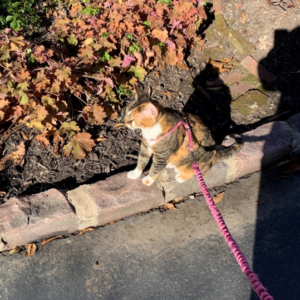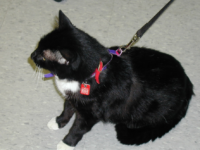Many cats learn to walk on a harness and leash, offering them the opportunity to safely explore outside with you as their guide. Being comfortable on a leash allows cats to walk around the yard or neighborhood, stretch their legs in new territory, and obtain environment enrichment to stimulate their mind and curiosity.
Essential Items
- A well-fitting harness
- A lightweight 5-6 foot leash (avoid retractable leashes)
- Your cat’s favorite treats for training sessions
Using a harness prevents your cat from slipping out of a collar or choking from pulling. Always pair food rewards with verbal praise to increase compliance, especially when treats are not available.
Teaching Leash-walking to Your Cat:
1. Introducing the cat to the harness
- Leave the harness and leash in your cat’s favored areas of the house so your cat can investigate them. Reward any interest with treats and praise.
- When your cat is relaxed with it around the home, place the harness near or on the cat. If the cat remains calm, reward them with food and praise.
2. Putting on the harness for the first time
- Once your cat is comfortable with the harness touching them, put the harness on and adjust the fit. Remove it after a few minutes and reward your cat.
- Gradually increase the time you leave the harness on, even if the cat just lies down and does not move. If the cat wishes, allow the cat to walk around the house while wearing the harness.
3. Attaching the leash 
- When the cat is at ease moving with the harness on, attach the leash and let the cat drag it around the house but watch carefully so that the leash doesn’t catch on anything or pull on the cat.
- Keep sessions short and always reward your cat for positive interactions. Then, remove the leash and harness.
4. Walking with the leash and harness
- Pick up the leash and follow the cat around the house without putting any pressure on the leash. If you want your cat to go in a certain direction, toss a favorite toy or treat in that direction. At the same time, use a verbal cue, such as “move here” (where you threw the treat) so the cat is rewarded for moving in the direction you verbally indicated.
- Reward your cat for going where you want. Continue this activity until your cat is very relaxed with wearing the harness and leash, and reacts to the verbal cue.
5. Taking the cat outside 
- If your cat has never been outside, open a door to a quiet, safe side of the house and let your cat become comfortable with it. Use a verbal cue, such as “Let’s go for a walk,” to let them know that now is OK to go outside.
- Encourage your cat to explore by tossing a treat or toy just outside the door. This helps your cat associate leaving the house with your verbal cue and reduces the likelihood of them darting out on their own.
Tip: It’s helpful to know when it might be quiet around the home as the cat will be experiencing new sights, sounds, and smells. A sudden loud noise (i.e., from a honking or moving car during rush hour, construction on a home next door, or a dog barking nearby), may frighten your cat and cause them to react (many times by running away or trying to hide).
6. Unstructured walking at home
- When your cat associates the leash and harness with the outdoors and your verbal cues, allow your cat to explore the yard or garden as they choose, walking beside them.
- Keep watch for any potential dangers.
- If your cat decides to go back to the house, let them return.
7. Venturing away from home
- When your cat shows interest in exploring other areas, and are comfortable with the outdoor sights and sounds, take them to safe places or start walking along safe pathways. Always be vigilant for oncoming people or other animals that might scare your cat.
- Continue to reward your cat and direct their exploration by tossing a treat in front of them if you want them to go in a certain direction. Continue to use verbal cues such as “move here” which you used before to get them to go to where you want.
- Avoid letting the leash get tangled and never pull on the leash.
Teaching your cat to walk on a harness and leash can open up a world of new experiences for both of you. By following these steps, using positive reinforcement and remaining patient, you’ll help your cat become comfortable and confident on a leash. Remember, every cat learns at their own pace, so take your time and enjoy the journey. Soon, you and your feline friend will be exploring the outdoors together, creating wonderful memories and strengthening your bond. Happy walking!



